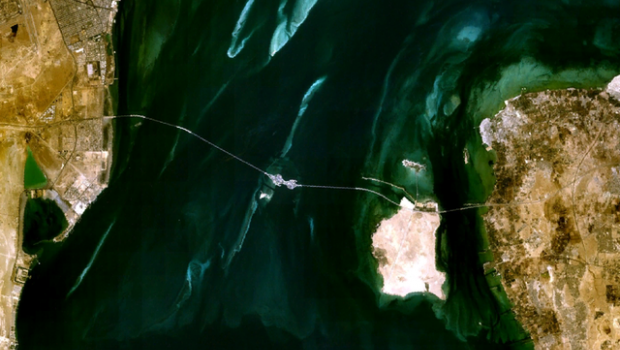Dammam, Asharq Al-Awsat—As one of the highlights of the “megaprojects” of the Arabian Gulf, the King Fahd Causeway is some 16 miles (26 km) long. Unfortunately, queues and traffic jams can at times also reach this length, as Badr Al-Atishan, the director-general of the project, admits.
Traffic on the causeway is getting heavier and heavier every year, and the bridge is in near-constant use. Official figures document an average of over 1.5 million vehicles traversing the bridge each month.
In operation since November 26, 1986, this vast structure connects the island of Bahrain to mainland Saudi Arabia, and it is utilized by all aspects of both Saudi Arabian and Bahraini society.
According to Col. Marai Al-Qahtani, the causeway’s passport manager, there were 11.27 million passengers during the first six months of this year. This is an increase of 1.34 million passengers over the first half of 2012, during which the crossing was used 9.88 million times. Compared with last year, there has been an increase of 6,000 vehicles per day.
And the trend shows no signs of slowing.
Qahtani explains that an average of over 50,000 vehicles cross the bridge each day. These figures are even higher on weekends and public holidays such as Ramadan and Hajj.
The causeway staff manage to handle these high traffic volumes despite the fact that when the bridge was built 27 years ago it was designed to accommodate 5,000 cars and 120 trucks per day. In part, this is made feasible by constant widening of the bridge.
The aim over the coming few years is to be in a position to accommodate as many as 250,000 daily users, which will require a huge effort. The most important such project is to build to adjacent islands on both sides of the sea border. By using them as terminals for customs and passport procedures, they should accommodate 100 million annual travelers—roughly five times the figures currently achieved.
The bridge authority has had to take urgent initiatives to deal with the growing use of the facility.
Speaking exclusively to Asharq Al-Awsat, Atishan said: “The implementation of the short-term plan saw the removal of sidewalks and the fountain, which resulted in increasing the number of lanes from 10 to 18. This meant the degree of usage was increased by 80 percent. Three of the extra lanes were dedicated to specific categories of travelers, such as students at universities in Bahrain, to ensure that they would not be late. There is also a lane for people with special needs and another for diplomats. Despite the expansions that have been announced, there are still those who are of the opinion the situation has stayed the same, with cars piled up for hours—especially on weekends.”
The director also considers that one of the main reasons for delays and traffic jams is that people tend to travel at the same time.
Atishan also said that his agency “is not the only one involved—there are passports, customs, and other agencies from both Saudi Arabia and Bahrain. Therefore, [we] cannot be considered responsible for every issue, whether small or large, especially with the issue of travelers being delayed at any given time.”
Col. Ahmed Al-Luhuaidan, spokesman for the Directorate of Immigration in Saudi Arabia’s Eastern Province, which is responsible for passport control, stressed that the directorate is making every effort to ease delays by opening all lanes and ensuring the continuous presence of staff.
He acknowledged that an increase in the number of passengers has had an effect on the speed at which proceedings can be conducted. The process is also made more difficult by the presence of two separate sets of passport control and customs, both of which must implement their own procedures. Luhuaidan also clarified that a booth for women had been opened, which works efficiently and simplifies travel for families.
As part of the preparations for Eid Al-Fitr, the General Organization for the King Fahd Causeway recently held meetings to coordinate with fourteen managers of governmental departments with regard to the crossing. There, they discussed preparations to deal with the expected large numbers of travelers and planned joint action to facilitate crossings.
Eid Al-Fitr sees a mutual exchange of travelers, with Saudi Arabian and Bahraini passengers using both sides of the bridge. It is expected that for this year’s Eid Al-Fitr, which falls at the end of the first day of August, more Saudi Arabians will travel to Bahrain than vice versa.


Trackbacks/Pingbacks